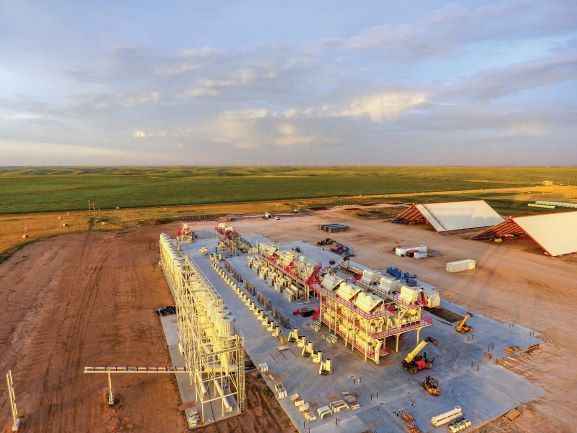Move over, corn.
In the past two years, cotton has surpassed corn as a mainstay crop across the Texas Panhandle’s northern plains. As water supplies dwindle and irrigation costs rise, more farmers are rotating from water-thirsty corn to shorter-season cotton varieties.
Cotton’s migration northward is expected to continue. The trend recently led a group of growers and investors to build a new high-capacity gin south of Pampa in Gray County.
Lonestar Gin — a $24 million facility financed by Plains Land Bank — opened for business in October. It is designed to process 150,000 bales annually.
“We’ve needed more ginning facilities in this area to handle cotton’s growth,” says Mike Friemel, Lonestar’s board president, who farms cotton in three Panhandle counties. “Farmers don’t get paid until their crop is ginned and graded. This new gin will focus on getting cotton ginned in a timely manner so farmers can get paid.”
120 Bales an Hour
Lonestar’s six gin stands and two presses can turn out 120 cotton bales an hour. The 5-acre gin complex includes a 450-by-195-foot plant, an office building and two seed warehouses. Each warehouse can store up to 6,000 tons of cotton seed. The yard can store 80,000 bales.
That’s a lot of ginning and storage capacity. But it was urgently needed, say growers.
Panhandle farmer Lance Williams harvested a bumper crop of cotton three years ago. So did other area producers.
“I sent my cotton to five gins,” says Williams, who’s a Plains Land Bank customer and now Lonestar Gin vice president. “They were all overwhelmed and running 60 to 90 days behind. My cotton was finally ginned by March.”
Meanwhile, Williams talked to potential investors about building a small gin. Then in the summer of 2017, he and Friemel got together with other cotton producers in Amarillo. Nearly everyone agreed to build a high-capacity gin in Gray or Carson county.
Moving forward, Friemel, Williams and Randy Darnell, who farms in Potter, Randall and Deaf Smith counties, sat down with directors of Windstar Gins.
The huge ginning company owns or is affiliated with several gins in the northern Panhandle. One of these, Adobe Walls Gin near Spearman, is the nation’s largest gin. It can process more than 350,000 bales annually.
“People in this area know Windstar,” Friemel says. “Windstar’s involvement gave everyone confidence in our project. So I knew they’d want to invest in Lonestar.”
80 Investors Sign Up
He was right. By May 2018, the project had signed on 80 investors with enough equity to build a six-stand gin. Twenty investors are Plains Land Bank customers.
More meetings led to a partnership with an energy provider.
That connection led to a prime location — a World War II air base located near an energy substation. The 640-acre property even came with water rights. The owner, the City of Pampa, agreed to a five-year lease-purchase agreement.
“It’s an ideal location,” Friemel says. “Plus, we have a fire hydrant on the gin’s northwestern corner. That’s a big deal. Hydrants are rare when you’re out in the country, and fires can happen at cotton gins.”
The northerly location — an hour’s drive northeast of Amarillo — also means the gin can serve cotton producers in Oklahoma.
Darnell, who is a Plains Land Bank director, lives too far from the gin to use it. Still, he wants to ensure his fellow farmers succeed.
“We have a lot of cotton up here,” Darnell says. “We need more infrastructure to handle the increase. Our primary goal is to take care of our farmers and handle their cotton in a timely fashion.”
Land Bank Finances Construction
In July 2018, Lonestar backers met with Plains Land Bank loan officers. Both parties agreed to a term loan for the gin’s construction.
“We were familiar with many of their investors,” says Blain Eubank, vice president and Pampa branch manager. “Because Windstar was a significant investor, that gave us a lot of confidence in the project.”
At times, figuring out financing details got tricky.
“Blain and his staff at the Land Bank were creative in structuring our loan,” Friemel says. “Every time we had a hurdle, they figured it out.”
Storms Hurt 2019 Harvest
Severe storms this past spring in the Texas Panhandle took out many cotton fields.
“We’re only expecting to gin about 30 percent of what had been predicted to be harvested,” says Carey McKinney, Lonestar’s gin manager. “That’ll probably be about 50,000 bales this first year. But in the near future, I’m hoping to gin as much as 200,000 bales.”
For his part, Friemel plans to plant more cotton, although he lost his entire crop this year.
“It was the perfect storm,” he says. “Wet, cold, wind, hail — everything that could go wrong did. But cotton is here to stay. It takes half as much water as corn and is an excellent rotation crop following corn. I flip them on the ground every year.”
As for his 2019 cotton losses, “if you’re not an optimist, you shouldn’t be a farmer,” he says. “The way I look at it, next year will be a great one, especially for cotton.”
Check out our Customer Success Story, One Post at a Time and our Landscapes Magazine.

